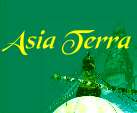The name Indonesia was derived from "indos nesos", meaning islands near
India, The country is in fact the largest archipelago in the world with thousands of islands, 17,508 to be precise, spread
in an area between the Asian continent and Australia, and between the Pacific and the Indian oceans. The islands are inhabited
by many tribes with diverse cultures and languages, although there is a national language spoken throughout the country, namely
Bahasa Indonesia. It is thus appropriate, that the country's motto is "Bhinneka Tunggal Ika", which means: "Unity in Diversity".
Our state philosophy is "Pancasila", or the "Five Principles".
The Indonesian archipelago's have sizes ranging from a tiny spot on the
map to the island of Sumatera which has approximately the size of the state of California. In fact, the island of Kalimantan
(or Borneo) is the second largest island in the world after Greenland. The archipelago spans the body of water that separates
and Australia.
The archipelago can be divided into:
- Sumatera
Including the Natuna Islands that stretch out towards Singapore
and Malaysia.
- Java and Madura
- Kalimantan (or Borneo)
- Sulawesi (or Celebes)
- Irian Jaya (or New Guinea)
- The Lesser Sunda Islands
Including Bali, Lombok, the Flores Islands,
and Timor.
- The Maluku Islands (or Moluccas) Scattered between Sulawesi and Irian Jaya.
| Land Area |
1,010,443 km2 |
| Climate |
Tropical |
| Average temperature |
21 - 33 oC |
| Mean annual rainfall |
700 mm |
| Population (1995 projection) |
195 million |
| Annual population growth |
1.7% |
| Life expectancy |
62 years |
| Major religions |
80% Moslem Others: Christian, Hindu, Buddhist |
| GDP (trillions Rp) |
375 (1995 projection) |
| GDP (billions US$) |
164 (1995 projection) |
| Growth rate |
7.2 % |
| GDP per capita (US$) |
840 |
| Inflation |
9.9% |
Visa
To gain entry into Indonesia,
foreign nationals need to have in their possession passports with at least six months of validity and appropriate visas.
Visa
application is carried out at the Indonesian Embassies or Consulates overseas nearest to the applicants' domicile
Climate and Weather
The climate
and weather of Indonesia is characterized by two tropical seasons, which vary with the equatorial air circulation and the
meridian air circulation. The dry season (June to September) is influences by the Australian continental air masses; while
the rainy season (December to March) is the result of the Asian and Pacific Ocean air masses.
Rivers and Lakes
Many rivers
flow throughout the country. They serve as useful transportation routes on certain islands, for example the Musi, Batanghari,
Indagiri and Kamper rivers in Sumatra; the Kapuas, Barito, Mahakam and Rejang rivers in Kalimantan; and the Memberano and
Digul rivers in Irian Jaya. On Java rivers are important for irrigation purposes, i.e. the Bengawan Solo, Citarum and Brantas
rivers. A number of islands are dotted with scenic lakes, like the Toba, Maninjau and Singkawang lakes on Sumatra; the Tempe,
Tawuti, Sidenreng, Poso, Limboto, Tondano, and Matana lakes on Sulawesi; the Paniai and Sentani lakes on Irian Jaya.
Fauna
Indonesia contains one
of the world's most remarkable geographical boundaries in its distribution of animals. This dates back to the glacial period
when sea level fell all over the world. During this period the islands of Java, Sumatra, Kalimantan and Bali on the Sunda
Shelf were joined together with one another and the Asian mainland, but Irian Jaya, Aru and the Australian continent of the
Sahul Shelf were separated. This early geographical separation explains why the tropical animal species of Java, Sumatra and
Kalimantan do not exist in Irian Jaya. For the same reason, the kangoroo of Irian Jaya is missing in the other region. Maluku,
Sulawesi, and the Lesser Sunda Islands, which lie between the Sunda and Sahul shelves, have a strikingly different fauna.
Most of the eastern fauna do not exist in Sulawesi even though this island is close to Kalimantan, being just across the Makassar
Strait. One possible reason for this is that Kalimantan and Sulawesi might have been separated by a deep straight at one point,
while the great depth of the Banda Sea kept them apart during the glacial period. Some scientists have attributed the phenomenon
to three faunial lines. ALFRED RUSSEL WALLACE (1823-1913) wrote in his book, "The Malay Archipelago", that Nusantara was separated
into the Oriental ecological area and the Australian ecological area by a Wallace L line that runs from the South to North,
passing the Lombok and Makassar Straits and ending in the south eastern part of The Philippines.
The rich flora of Indonesia includes many unique varieties of tropical plant life in various forms.
Rafflesia Arnoldi, which is only found in certain parts of Sumatra, is the largest flower in the world. The parasitic plant
grows on certain lianas but does not produce leaves. The myriad of orchids in rich in species, varying in size from the largest
of all orchids, the tiger orchid of Grammatophyllum Speciosum, to the tiny and leafless species of Taeniophyllum which is
edible and taken by the local people as a medicine and is also used in handicrafts. On June 5, 1990, in a ceremony to mark
the World Environment Day, President Soeharto declared three flowers as Indonesia's national flowers: the melati (small white
sweet smelling flower), the angrek bulan (moon orhid) and the Raflesia Arnoldi, named after Sir Thomas Stamford Raffles and
Dr. Arnold. About 6,000 species of plants are known to be used directly or indirectly by the people. A striking example in
this modern time is the use of plants in the production of traditional herbal medicine or "Jamu". Flowers are indispensable
in ceremonial, customary and traditional rites.

